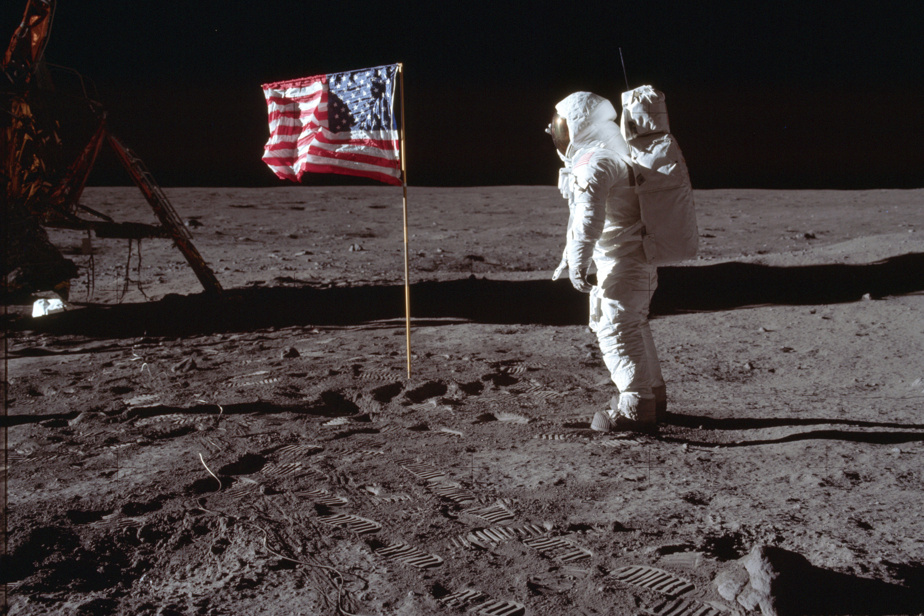(Cape Canaveral) We will have a full moon for the 55the anniversary of the first moon landing this weekend. Many events will honor Neil Armstrong and Buzz Aldrin’s giant leap for humanity.
Mr. Aldrin, 94, the last surviving member of the Apollo 11 crew, headlines a gala at the San Diego Air and Space Museum on Saturday night. He will be joined by astronaut Charlie Duke, the voice of Mission Control during the July 20, 1969, moon landing.
Museum President Jim Kidrick couldn’t resist throwing a party “55 years to the day after one of the most historic moments not only for America, but for the entire world.”
Can’t make it to San Diego, Cape Canaveral, or Houston? There are plenty of other ways to celebrate the moon landing, including the new movie Take me to the moona light-hearted return to the past that features Scarlett Johansson.
The San Diego Air and Space Museum has designed a website in partnership with the Smithsonian Institution specifically for the 55e birthday.
Here’s a look at some of the tributes that will be paid to Apollo 11.

PHOTO ARCHIVES NASA
THE Saturn V Apollo 11 launches with astronauts Neil Armstrong, Michael Collins and Buzz Aldrin on July 16, 1969.
“The Eagle has landed”
NASA’s Kennedy Space Center is hosting a moon party at its tourist attraction, just miles from where the rocket launched. Saturn V flew with Mr. Armstrong, Mr. Aldrin and Michael Collins on July 16, 1969.
Four days after leaving Earth, Mr. Armstrong and Mr. Aldrin, in their lunar module, Eaglelanded on the Sea of Tranquility at 4:17 p.m. with almost no fuel left. “Houston, this is Tranquility Base. The Eagle has landed,” Armstrong radioed from 240,000 miles (386,000 kilometers) away.
“No moment has united the country like when the Eagle landed, while all of planet Earth looked down,” NASA Administrator Bill Nelson said in an anniversary message Friday.
“One small step”
“That’s one small step for man, one giant leap for mankind,” proclaimed Neil Armstrong as he became the first person to walk on the moon.
The astronaut grew up in Wapakoneta, in northwest Ohio, which is now home to the Air and Space Museum. Saturday begins with two “Moon Races,” followed by model rocket launches. John Glenn, the first American to orbit the Earth, is from New Concord, on the other side of the state, about 150 miles away. The John and Annie Glenn Museum will be open there Saturday.

PHOTO NEIL ARNSTRONG/NASA, CANADIAN PRESS ARCHIVES
Buzz Aldrin on the surface of the moon, July 20, 1969.
“Magnificent desolation”
Buzz Aldrin followed Neil Armstrong to the moon, calling it “magnificent desolation.” They spent just over two hours roaming the dusty surface before returning to their lunar module and blasting off to join Mr. Collins, the command module pilot who remained in lunar orbit.
Armstrong’s spacesuit was restored in time for the 50the anniversary in 2019. It is on display at the National Air and Space Museum in Washington, along with their return capsule. Mr. Collins died in 2021, less than a year after the 50the anniversary; Mr. Armstrong himself died in 2012.
Splashdown!
The capsule containing the three men – nicknamed Columbia — splashed down in the Pacific on July 24, 1969. They were recovered by the USS Hornet, a Navy aircraft carrier that repeated the work for Apollo 12 four months later. The Hornet is now part of a museum in Alameda, California, and a splashdown party is planned aboard the ship Saturday.
Some members of the original recovery team will be present. The Apollo 11 astronauts were immediately quarantined aboard the Hornet and, along with 22 kilograms of moon rocks and soil, remained isolated for weeks while they were being transferred to Houston. Scientists feared the astronauts had brought back lunar germs.
Most of the rocks remained locked away in a laboratory at Johnson Space Center in Houston. The Apollo program sent 12 astronauts to the moon between 1969 and 1972.
Next stop: Apollo’s twin
NASA aims to send four astronauts to the moon next year – under a program called Artemis, named after Apollo’s twin sister in Greek mythology. The rocket SLS – abbreviation of Space Launch System – is expected at the Kennedy Space Center next week. It arrives by barge from NASA’s Michoud Assembly Facility in New Orleans.
The rocket will lift off in September 2025 – at the earliest – with three American astronauts and one Canadian. None of them will land on the moon; that will happen on a follow-up mission with another crew in 2026 at the earliest.
The Associated Press Health and Science Department receives support from the Howard Hughes Medical Institute’s Science and Education Media Group. The AP is solely responsible for all content.
